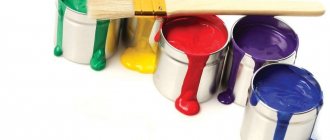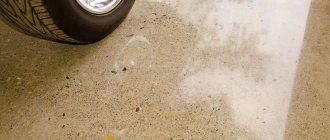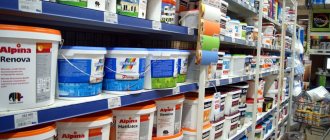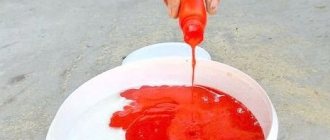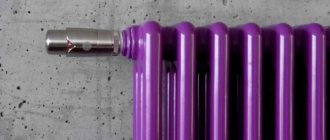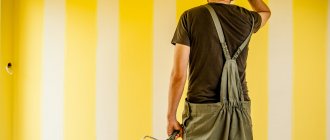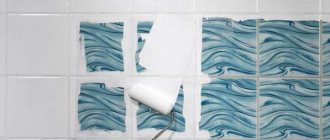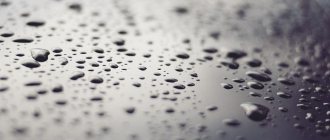Alkyd
They are produced on the basis of modified alkyd resins, so such dyes are elastic and durable. Manufacturers produce the product in cans.
| pros | Minuses |
|
|
How to choose paint
When choosing paint for forged products, you need to consider only metal coatings. Considering that the material used for artistic forging is ordinary steel, which is susceptible to rust, as well as the roughness of the metal surface and the presence of many joints at the joints of parts, forging paint must meet the following requirements:
- Contain anti-corrosion components. Painting should protect the forging from rust and environmental influences during operation, because forged products are often placed outdoors: external fences, canopies, lanterns, twisted fences and gates, decorative forged figures, etc.
- Wide temperature range of use (for external use). The paint must be resistant to temperature changes in the region in which it is planned to be used; for Russia this range averages from -40 to +40 °C. Pay attention to the information provided by the manufacturer so that the coating does not crack in winter or spread in summer.
- Resistance to mechanical damage. There should be no scratches on the coating from minor damage or impacts.
- Possess high adhesion. The coating should not peel off during use. High-quality coloring allows forged products to look new for several years.
- UV resistance. It should not fade or change color.
- Plastic. It should lie flat on a rough surface, mask welded joints well and paint hard-to-reach places. This will ensure an attractive appearance of the finished product and protect it from rust.
- Environmentally friendly. Choose a non-toxic composition, especially for painting interior forged products (fireplace grates, lamps, etc.). It is important that the paint is non-toxic not only during application, but also after drying.
If patination of the metal is chosen as the finishing touch (giving the effect of antiquity), it is necessary that the paint with which the patina is applied lies smoothly, does not rub off or lose color.
Acrylic
Acrylic paints are produced on the basis of polyacrylates. They are also available in cans. They are very durable, so they will retain their protective properties for a long time without updating the paint layer.
| pros | Minuses |
|
|
Oily
The main components of the compositions are natural oils and drying oil. The product is also available in cans, but does not need to be diluted before use. Such compositions are often used for painting indoor forged products.
| pros | Minuses |
|
|
Methods for degreasing forged items
Before priming new forged parts, degreasing is carried out. Ferrous metal products that come straight from the factory may have grease or oil stains on their surface. Some elements are treated with different lubricants to protect against corrosion. Several means are used for degreasing:
- hot caustic soda solution;
- isopropanol, acetone, composition 646, butyl acetate or other solvent;
- a water-soap solution heated to 90°: first boil the water, then add finely shaved household soap to it with stirring;
- synthetic detergent diluted to 5%.
Important: When working with chemical compounds, you should use safety glasses, a mask and gloves. It is not recommended to touch grease-free areas of surfaces with your hands.
Epoxy
The composition is based on silicone resins, which are highly resistant to temperature changes. Paints are also available in cans.
| pros | Minuses |
|
|
Types of coating for forged products
Forged products are coated with different materials to increase durability and aesthetics. To obtain a beautiful protective layer for the structure, chemical or thermal bluing is used. The material can be coated with hammer, forge, powder paint and (or) finished with bitumen, polyurethane or other varnish.
Beeswax coating
One of the many materials used to treat forged steel is beeswax. With its help, in an old-fashioned but effective way, the surface of the metal acquires a black surface. Beeswax not only gives forged products a pleasant appearance, but also protects the steel from corrosion. The product can be applied at home in the following sequence:
- the surface is degreased and free of rust;
- gas oven heats up to 204 °C;
- the forged part is placed on a metal baking sheet;
- the element warms up well: the holding time of the part in the oven depends on its cross-sectional dimensions;
- the steel product is removed and ventilated in fresh air;
- beeswax is mixed with linseed oil, and then applied to the surface with a cotton cloth;
- so that the wax melts, the element is placed back in the oven for 20 minutes;
- After removal, the product is given time to cool.
Steel can be heated in any other device - the main thing is that the temperature regime is maintained. Beeswax does not need to be mixed with linseed oil before application, but it gives better results.
Blueing
As a result of bluing, the surface of the forged product is covered with an oxide film and becomes black. In addition to its aesthetic appearance, the metal gains a high degree of protection against corrosion. To obtain a noble black color, various chemical and thermal methods are used. You can get the desired effect not only in production, but also at home.
- Alkaline bluing. 1.1 liters of water is poured into a stainless steel bath, to which 1 kg of technical soda and a little sodium nitrate are added. The forged part is placed in a solution mixed and heated to 150 °C for 0.5 hours.
- Acid bluing. To create an oxide film on the metal, a solution is prepared in a ceramic or porcelain container. 4 g of tartaric and tannic acids are added to 2 liters of water. The element, immersed in the solution for 20 minutes, is washed, wiped and dried. The method is suitable for unhardened copper and steel products.
- Thermal bluing. The essence of the method is to heat the forged part to a temperature at which oxygen in the air will enter into a chemical reaction with the surface of the metal. The more the element heats up, the blacker the color it will become.
Another method is oil bluing. The part placed on the brick is heated strongly by a gas burner: the metal should glow until it glows. The heat-treated element is placed in a container with oil, and then placed on a paper towel. The procedure is repeated about 5 times.
Important: Chemical methods are very toxic. They should be used in a well-ventilated area or in the fresh air.
Clear nail polish
Bituminous varnish improves the physical and chemical characteristics, as well as the performance properties of forged elements. Paintwork materials consist of a special grade of bitumen, polymer resins and solvents. After hardening, a black tint forms on the surface. The varnish is inexpensive and effective. Manufacturers recommend it only as a temporary means of protection and aesthetic treatment of metal.
Polyurethane varnish is used to coat parts made of steel, aluminum and cast iron. Apply at air temperatures from -30 to 60 °C. After drying it can be glossy, matte or transparent. Suitable for copper and its alloys. The polyurethane-based composition has high performance, including anti-corrosion properties. Withstands temperature changes from -60 to 80 °C.
Acrylic varnish protects forged products made of non-ferrous and ferrous metals well. Apply with a brush, spray or can. The film, which dries quickly, is not afraid of moisture and high temperatures. Alkyd varnish is applied at temperatures from 5 to 30 °C. Gives the surface of the forged product a glossy shine. It withstands shocks and exposure to ultraviolet radiation, moisture and temperature changes.
Powder coating
Powder paint is a high-tech polymer material that does not contain solvents. When sprayed onto a forged product, dry particles become electrically charged: the process occurs as a result of their friction with each other or under the influence of an external source. Through an electric field, particles stick to the forged product with the opposite charge. The element processed in this way is transported to a special chamber for polymerization using the powder baking method.
Stages of formation of the protective layer:
- the particles melt to form a viscous-fluid state;
- the amorphous material gradually turns into a monolithic layer;
- The hardening polymer, firmly bonded to the metal, forms the finishing coating.
In the final stage, the film is formed by curing or cooling. When using thermoset materials, natural curing occurs. Thermoplastic analogues achieve operational properties when cooled.
Dye
Hammer paint got its name because of the potholes formed on forged products, which also appear on metal surfaces after hammer blows. On the dried relief layer, small flaws that occur on the surfaces of hand-forged products are not visible. The composition is applied with a brush, swab or spray gun. You can paint with a 3-component product even on an untreated rusty surface. The resulting coating is durable because it is resistant to many influences, including vandalism.
Important: Hammer paint has a thick consistency, so it is more practical to apply it not with a sprayer, but with hand tools.
Forge paint, which is expensive, is considered the highest quality and most durable. Since the service life of the composition exceeds 25 years, it more than pays for itself. Consists of polymers that are resistant to various influences. Apply after a primer from the same manufacturer, even at sub-zero temperatures. Dries very quickly.
ML paint is a product of Russian manufacturers. It was created as an alternative to hammer enamel. This paintwork material is inferior in quality to foreign analogues, but superior to conventional oil paint. Compared to PF, ML has better resistance to mechanical stress and a longer service life.
Primer-enamel
They are designed specifically to cope with existing rust. They cover the metal with a dense layer and reliably protect it from any negative influences.
| pros | Minuses |
|
|
Differences in painting technologies
The choice depends on the area, time spent on painting and your quality requirements. I don’t consider exotic methods such as dip painting. What remains?
- Spray painting - with a can or spray gun (see Fig. 2).
- Painting with a brush (see Fig. 3).
And no rollers! Your fence is not a flat and boring surface!
Let's go back to the neighbor. He turned out to be an avid motorist, so he thought that the paint still didn’t know what it was painting – a car or a fence, so he chose painting using a spray gun.
Moreover, he is familiar with the sequence: cleaning the surface from dirt and rust, preparing the compressor, priming and painting.
Wrought iron fence painted with black and bronze paints
Important! Forged fences do not represent a continuous surface, so the stream will definitely fall on the grass or exterior elements of nearby buildings. Therefore, you should use a plywood shield, which should be located behind the fence, at a distance of 300-500 mm from it.
Spray painting Painting
with a brush is a more relaxed activity; neither shields nor a compressor are needed. Be sure to move your brush, not forgetting to work the corners: according to the law of meanness, this is where droplets of moisture hide unnoticed.
Important! Do not forget to periodically clean the brush from paint deposits, otherwise the applied layer will be uneven.
Painting forged fences with a brush
“A smart thought comes later.” A neighbor told me this after he painted the fence. It turns out that there is a technique that allows paint to settle quietly on any surface.
To do this, you just need to get an electrostatic sprayer, which ensures 100% adhesion of the paint to the metal (see Fig. 4). A neighbor has already purchased such a thing. He says that sooner or later the fence will still have to be painted.
Electrostatic fence painting process
Advice: you are unlikely to find paint exactly the same color over time. Don't be upset: with a little imagination, your fence can be turned into an art gallery of modern art. Free.
Anti-corrosion
These compounds are designed specifically to protect metal from corrosion. Also available in cans. Contains synthetic resins and anti-corrosion pigments.
| pros | Minuses |
|
|
Special compositions for forged products
Forging paints for forged coatings
After painting metal surfaces with a special composition, artistic forging acquires the color and shade necessary for a given interior, and the composition also protects the coating from corrosion. There are several types of special WS-Plast forging paints made in Germany, which are among the highest quality. Since they are made from acrylic binders, their service life reaches 8 years. This paint and varnish material is applied to various surfaces, even to those already painted. But at the same time it is necessary to do a test painting. In this case, the paint consumption is 125 grams per 1 m2.
Among blacksmith paints, another composition that should be highlighted is WS-Patina with a patina effect, which creates the effect of gold, copper or silver. Also interesting is the Zinga coating, which is a ready-made solvent-based composition. Such a coating will help effectively protect the metal surface from physical and electrochemical factors, as well as from corrosion. Thanks to this, the wear resistance of the coating is more than 40 years, it all depends on the thickness of the applied composition. In addition, some companies offer primer and paint in the same alkyd base that are ideal for forged products.
Three-component paints
Recently, special three-component paints have been developed, where one container contains a rust transformer, a primer and a decorative coating. This allows you to apply the composition directly to the rust, without forgetting to clean off its loose layer. Currently, such compositions are produced by both foreign and domestic manufacturers. The highest quality compounds are from Hammerite. As a result of the fact that solvents evaporate very quickly from painted surfaces, artistic forged products dry in 60-90 minutes. Of the domestic manufacturers, the most popular are paints from.
This paint contains Novax alkyd-based enamel with anti-corrosion properties and a two-component composition designed specifically for use in aggressive environmental conditions.
Thus, today the market offers a large assortment of paints and varnishes for wrought iron gates or fences, as well as for other similar products. When applied correctly, these compounds will provide long-term protection of the metal from corrosion.
Nitro paints
Their marking name is NC. Such paints are often produced in cans and applied by spraying, so they are most often used for painting small forged products. Used mainly indoors.
| pros | Minuses |
|
|
Painting forged products with liquid paints
Preparing the base
Before painting forged products, you need to do some preparatory work. It depends on them how much the forging will be protected from corrosion and how long its decorative finish will last.
Rust and old paint must be removed
Surface preparation is performed in the following order:
- If the product is not new and has already been painted, then first of all you need to remove the old layer of paint. To do this, you can use sandpaper, a hair dryer, or a special chemical composition called a remover. The last option is the simplest and fastest, but at the same time, the most toxic.
- After the old coating is removed, the metal must be cleaned of rust. Ideally, the surface should be sandblasted. At home, you can use a wire brush or sandpaper.
- Then the stripped metal must be degreased; to do this, wipe the surface with a rag soaked in white spirit or another suitable composition.
- The final stage of preparation is applying a layer of soil to the surface. In fact, this procedure is practically no different from painting. This can be done with a spray or brush.
The primer must be stirred well with a stick before application. It is applied in an even thin layer. Depending on the type of composition, you may need to perform the procedure in two passes.
Note! The primer for forging must have good anti-corrosion properties. Cold galvanizing is often used for these purposes.
Applying primer
Painting
You can begin further work after the primer layer has dried.
Painting instructions consist of several stages:
- You need to start work by preparing the paint. First of all, you need to stir it thoroughly and, if necessary, dilute it to obtain the desired consistency. The type of solvent depends on the type of paint.
- Then the composition is applied to the prepared surface. Good paint for forged products itself will not leave streaks, however, you need to make sure that it is applied in an even, thin layer, without drips. To paint hard-to-reach places, you can use a thin brush with a curved handle.
- To achieve the best effect from painting, after the first layer has dried, this operation must be repeated.
- To ensure the greatest durability of the coating and protection from mechanical damage, a layer of protective varnish can be applied to the paint.
The photo shows a forged product coated with powder paint.
Hammer
These are three-component compositions that create the original texture of the final color. They are available in cans and must be diluted with an acid or solvent before use.
| pros | Minuses |
|
|
Features of blacksmith paints
Forge-type dyes are distinguished by the presence of a large number of anti-corrosion fillers - aluminum powder, fine glass, etc. This enamel can be applied not only to metal, but also to surfaces made of wood, hard plastic, glass, and ceramic tiles.
Some compositions require preliminary priming, others combine the characteristics of a primer and a decorative coating. In difficult areas, primer-enamels with a rust converter are used.
Once the appropriate composition has been applied, the rust is converted into a chemically neutral, durable coating, thereby enhancing the anti-corrosion properties of the primer solution.
Blacksmiths
They are produced on the basis of polymers, especially for forged products. Therefore, such compositions are distinguished by optimal characteristics adapted to the needs of the metal in forged structures.
| pros | Minuses |
|
|
Preparing metal for patination
- Prepare a smooth surface on the forged product. Remove uneven areas with a file and sandpaper, and then coat the item with a special metal primer. Check that there are no rust stains left.
- Before decorating a forged item, paint the product, and then be sure to let the paint dry . The paint will cover the primer layer and create a spectacular background for the future patina. Gold or silver patina looks especially good on dark tones.

